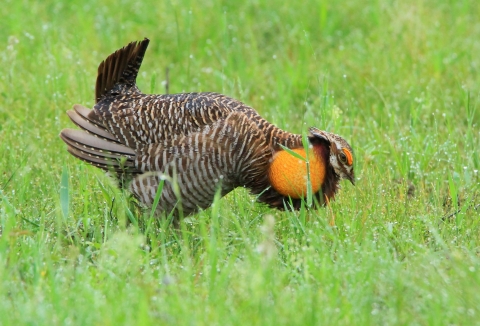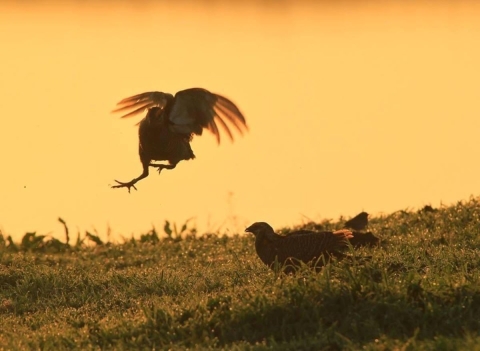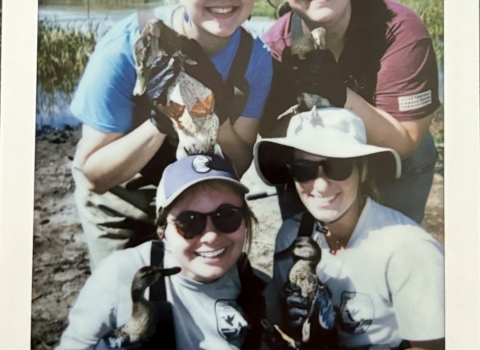It’s not very big for a grouse, but what it lacks in size it more than makes up for with its impressive dance moves and vocals. It’s the Attwater's Prairie Chicken.
In April, about 300 people came to see the males of this barred grouse inflate his yellow air sacs and shimmy back and forth for his annual mating ritual, celebrated at the festival and National Wildlife Refuge bearing their name. There are only a few dozen of the chickens left living in the wild, mostly at the refuge near Houston. They once numbered about one million, throughout the coastal grasslands of modern-day Texas and Louisiana.
Like most endangered species, their numbers have been shrinking over the past century due to habitat loss. In more recent decades, the expansion of invasive fire ants to the southeastern U.S. dealt a near final blow to this prairie chicken subspecies. By spring of 2014, they numbered around a hundred left in the wild.
In the spring of 2016, flooding wiped out an entire generation of nests and eggs. The next summer in 2017, Hurricane Harvey spelled further disaster. The heavy rains drove the birds, along with their predators, to remaining slivers of dry land. A few who remained were gathered up by biologists, and sheltered at the Houston Zoo.
They’ve since been repatriated to the refuge. So far, 2018 has been stable, and the Attwater’s festival attendees weren’t disappointed.
To get a deeper look on the recovery science, we’re talking shop with Mike Morrow. He’s a U.S. Fish and Wildlife Service wildlife biologist at the Attwater Prairie Chicken National Wildlife Refuge in Eagle Lake, Texas. He earned his Ph.D. studying the Attwater’s. Along with other partners, Mike’s charged with the daunting task of recovering a bird whose wild population is heavily dependent on captive breeding and sheltering in zoos.
“The Attwater's prairie chicken is essentially extirpated from the wild, and so we have several captive rearing facilities at three zoos across Texas to re-establish populations in the wild. We're releasing birds at the Attwater Prairie Chicken National Wildlife Refuge and on to private ranch land.”
Less than three percent of Texas’ lands are public, and less than one percent of the Attwater's original habitat, the western Gulf coastal grasslands, remains pristine. Thus, cooperation with private landowners is the main hope for the recovery.
“The Attwater’s prairie chicken currently occurs in two locations in Texas right now: one is here at the refuge where I work. The other is on r private ranch in Goliad County, Texas. Being able to work with landowners interested in restoring the Attwater’s population is critical to the ultimate goal of removing the Attwater's from the endangered species list.
“Most of Texas is in private landowner ownership so without the help and assistance of private landowners recovery of the species, which is emblematic of healthy tall grass prairie, recovery of the Attwater’s simply wouldn't be possible”
And therein lies a real challenge. Private parties are can be skeptical about lending their livelihood to public conservation. However, what’s good for cattle ranchers is also good for the Attwater's.
“Attwater's are residents of a good, quality coastal prairie habitat that once occurred on some six million acres along the coast of Texas and Louisiana. However, right now it’s been estimated that much less than one percent of that remains.
“One of the early pioneer researchers from the ‘30s and ‘40s stated that ‘it’s upon the existence of adequate prairie habitat that the welfare of the prairie chicken depends.’ So prairie chicken management is synonymous with prairie management.
“There are several things that landowners can do that would benefit not only Attwater’s, but the ranching and cattle operations as well. Ranchers that manage their native prairie grasslands using sound range management practices are already practicing prairie chicken management.
“Prairies in this part of the world and in general are a very dynamic ecosystem; they evolved with various disturbances that maintain these areas as grasslands. If the prairies aren't are disturbed in some way they will eventually grow up into brush lands and ultimately forests.
“Things like grazing and periodic fire are important to maintain prairie. The key is to apply enough disturbance to maintain the open prairie landscape but not so much that the characteristic grass species are eliminated.”
Cattle have that in common with the Attwaters. They prefer grasses. So keeping out invasive brush and trees is good practice to provide forage for ranching. The chicken prefers the grass for an unobscured view.
“They really depend on that wide open landscape to detect predators so that they're not ambushed. They're very strong fliers and can outfly just about anything on wings.
“Attwater’s management is something that private landowners can and do on their own. That can mean cutting brush, treating with herbicides, treating with prescribed fire or a combination of all the above. Those kind of practices not only improve the property for prairie chickens but also result in increased forage for livestock operations as well.”
More recently, Mike and his colleagues were able to make a major breakthrough in Attwater’s recovery. They discovered a major setback for the chicken. It’s something that causes trouble for pretty much everybody the southeastern states: the imported red fire ant.
The fire ants started to make big impacts on Texas lands by the 1960s. Mike and his team discovered that the ants compete with newly hatched chicks for insect forage, which was leading to chick starvation. They started treating the fire ant nests on the refuge land with insecticide.
“If we treat to reduce fire ants we can increase insect abundance by about twenty seven percent, but even more importantly, where we have treated for fire ants, brood survival during that critical two weeks post hatch was comparable to historic Attwater's brood survival.”
So, now we have a solution. Maintain the prairie landscape with moderate grazing and periodic fire. Keep out remove invasive plants and ants. Things were going swell at the refuge. Then along came two consecutive years of devastating floods on the tiny wild population. The work around for natural disaster is redundancy - the Attwater’s needs more habitat so they can recuperate from future flooding, which happen periodically in this part of the world.
To get the population redundancy we need more habitat. It comes down to identifying more lands that can be converted back to native prairie, so that disaster events aren’t so catastrophic. A major roadblock to getting this is that ranchers have replaced native prairies with introduced grasses, which have higher maintenance costs in exchange for higher more food for cattle. A goal for conservation agencies is to highlight the economic viability of native grasses.
“Native prairies have been used to support ranching operations throughout Texas history. Native pastures don't require a lot of monetary inputs in the form of fertilizer and water to keep them productive like these so-called improved introduced pastures.
“Native prairies can't be stocked as heavily as improved pastures, so it doesn't carry as many animals per unit of area as say pastures planted with introduced species like Bermuda grass. But the data I've seen suggest that when looking at the bottom line, native prairies are just as profitable as these introduced improved pastures.
“Because native grasses have evolved with periodic droughts that are characteristic of prairie environments, they are more resilient to dry conditions than the introduced ‘improved’ species.”
The economic stability of private lands can be further enhanced through Safe Harbor agreements with the Service, which can protect landowners’ operations.
“Landowners are oftentimes uncomfortable with creating habitat for a species that is listed under the Endangered Species Act. With the Safe Harbor program, landowners can enter into agreement to manage the Attwater’s with the hope that actions they put on the landscape will result in an increase of prairie chickens on the property.
“However as a part of that Safe Harbor agreement, landowners are only responsible for maintaining the baseline number of prairie chickens present when the agreement was signed.
“For most remaining grasslands within the historic range of Attwater's that baseline is currently zero. That gives the landowner some flexibility if they change their mind about the management in the future, and relieves them from stress and worry over potential burdens that the endangered species or perceptions of burdens may impose if they they do indeed change their minds and want to take management of the property in a different sometime down the road.”
Mike Morrow has been working with the Attwater’s for several decades. And while recent years have been hard for Attwater’s numbers, he’s confident that recovery is on the horizon.
“I've been working with Attwater’s for a long time. More than 30 years. It's been an incredibly frustrating ride at times, but I will say even with the setbacks that we've had in the last two or three years, I feel more optimistic about the Attwater’s recovering now than I have for most of my 30-year career. The Attwater’s is in a tough spot now, but we think we now know what the limiting factor was.
“The indirect effects of fire ants on insects required by the Attwater's chicks frustrated our efforts for so long. So we know what to do and the data that we've been able to collect so far indicate that we're on the right track.
“Mother nature's dealt us a string of bad luck with the weather in recent years, but that's not going to last forever and I'm more confident than I've ever been that we're going to make some significant strides in in the recovery of the Attwater’s in the not-too-distant future.
“I don't want to count the Attwater’s out yet. We're going to get there.”






